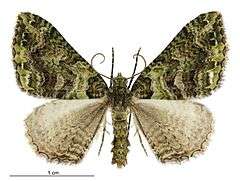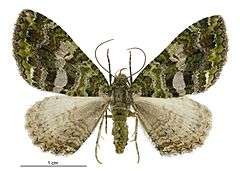Austrocidaria similata
Austrocidaria similata is a species of moth of the family Geometridae. It endemic to New Zealand.
| Austrocidaria similata | |
|---|---|
 | |
| Male | |
 | |
| Female | |
| Scientific classification | |
| Kingdom: | |
| Phylum: | |
| Class: | |
| Order: | |
| Family: | |
| Tribe: | |
| Genus: | |
| Species: | A. similata |
| Binomial name | |
| Austrocidaria similata | |
| Synonyms[2] | |
| |
Taxonomy
It was first described by Francis Walker in 1862 using a specimen obtained by William Colenso and named Cidaria similata.[3] The holotype specimen is held at the Natural History Museum, London.[2]
Distribution
A. similata is endemic to New Zealand.[1] This species is found on the Auckland Islands, Campbell Island, Snares Islands, the Chatham Islands and mainland New Zealand, Stewart Island and Codfish Island.[4][5]
Biology and behaviour
Adults are on wing in December, February, May and September.[6] The larvae feed on Coprosma species.[7]
gollark: How fun.
gollark: It also produces nice not-actually-static-exactly binaries, which is useful for purposes.
gollark: Anyway, Nim:- is reasonably fast (even if certain libraries are beelike)- has nice syntax- has decent library existence- is able to bind to C stuff, which I have actually used in this because cmark-gfm is very fast- is fairly pleasant to write- has cool metaprogramming- has a compiler which mostly runs bearably fastthus I am using it.
gollark: `openring`, that is, which generates the "from other blogs" bit on my website.
gollark: Also, in the past I had to write about three lines of code to make a Go project faster, because despite Go's main thing being parallelism the authors did not bother to parallelize it despite it being trivially possible to do so.
References
- "Austrocidaria similata (Walker, 1862)". www.nzor.org.nz. Landcare Research New Zealand Ltd. Retrieved 2017-08-23.
- Dugdale, J. S. (1988). "Lepidoptera - annotated catalogue, and keys to family-group taxa" (PDF). Fauna of New Zealand. 14: 176. Retrieved 24 September 2019.
- Walker, Francis (1862). "Part XXV: Geometrites (continued)". List of the Specimens of Lepidopterous Insects in the Collection of the British Museum. 25: 1281–1477 – via Biodiversity Heritage Library.
- Patrick, B. H. (1997). "Codfish Island moths". The Weta. 20 (1): 17–20. CiteSeerX 10.1.1.728.6325.
- Marris, J. W. M. (2000-06-01). "The beetle (Coleoptera) fauna of the Antipodes Islands, with comments on the impact of mice; and an annotated checklist of the insect and arachnid fauna". Journal of the Royal Society of New Zealand. 30 (2): 169–195. doi:10.1080/03014223.2000.9517616. hdl:10182/5721. ISSN 0303-6758.
- Lyford, Brian M. (1994). "Lepidoptera and Trichoptera from Paroa, near Greymouth, New Zealand". New Zealand Entomologist. 17 (1): 46–51. CiteSeerX 10.1.1.728.7273. doi:10.1080/00779962.1994.9721984. ISSN 0077-9962.
- Department of Conservation (July 2005). Crown Pastoral Land Tenure Review - Lake Hawea part 1 (PDF) (Report). Land Information New Zealand. Retrieved 22 August 2017.
This article is issued from Wikipedia. The text is licensed under Creative Commons - Attribution - Sharealike. Additional terms may apply for the media files.